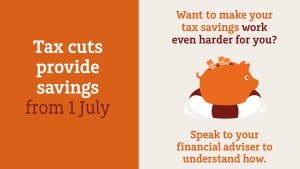Super Guarantee
The rate of super guarantee contributions from employers will increase. In line with existing legislation, the rate of super that an employer is required to pay for employees will increase from 10% to 10.5% from 1 July 2022.
This change will happen automatically. Care needs to be taken to ensure the additional super guarantee contributions won’t push you into having excess concessional contributions in the future, with the general cap for concessional contributions currently set at $27,500 per annum.
More employees may now be eligible to receive super guarantee payments
From 1 July 2022, the $450 monthly minimum threshold that has applied before an employer has been required to make super guarantee payments will be removed.
This means employers are obligated to pay the 10.5% super guarantee for all their employees, regardless of how little the employee has been paid for the month.
The only exception is if the employee is under 18 years of age, in which case they will need to have worked for at least 30 hours in the week to be eligible.
Removal of the work test requirement for personal non-concessional and salary sacrificed contributions.
From 1 July 2022, the work test has been removed completely for non-concessional contributions, meaning eligible clients can make these until they turn 75.
Individuals will still need to have a total superannuation balance below the $1.7million threshold as at the previous 30 June to be able to make a non-concessional contribution.
The work test has also been removed for salary sacrificed contributions.
Work test still required to be met for personal deductible contributions
Individuals who are over age 67 and wish to claim a tax deduction for a personal contribution made to their super from 1 July 2022, will still be required to meet the work test requirements.
This means individuals will need to have been gainfully employed (which includes being self-employed) for at least 40 hours within any consecutive 30 day period in the financial year.
Alternatively, individuals may meet a work test exemption in certain limited circumstances.
Eligibility for bring forward non-concessional contributions also extended
With the ability to make non-concessional contributions having been extended to age 75 from 1 July 2022, the ability to utilise the bring forward provisions to make up to three years of contributions in one year has also been lifted.
From 1 July 2022, individuals who are less than 75 at any time in the financial year would meet the age based criteria to trigger a bring forward contribution. This means a contribution of up to $330,000 (based on the current limits) could be made.
However, it is important that whilst the bring forward contribution is available in the financial year the client turns 75, they would need to make the contribution before they turn 75, as non-concessional contributions cannot be made after that time.
The level of bring forward available is also determined by how far an individual’s total super balance is below the total super balance threshold of $1,700,000 as at the previous 30 June.
Reduced minimum payment requirements from account based income streams
The 50% temporary reduction in the minimum payment required from account based pensions will be extended from 1 July 2022 for another 12 months. The minimum drawdown requirements for the year commencing 1 July 2022 are shown in the following table:
Age at 1 July 2022
| Standard minimum percentage of Account Balance required to be paid | Reduced minimum rates for the 2022/23 financial years |
Under 65 | 4% | 2% |
65 to 74 | 5% | 2.5% |
75 to 79 | 6% | 3% |
80 to 84 | 7% | 3.5% |
85 to 89 | 9% | 4.5% |
90 to 94 | 11% | 5.5% |
95 or more | 14% | 7% |
Eligible for downsizer contributions from an earlier age
The downsizer contribution allows many older Australians to make additional contribution to their super when they sell their main residence, with the contribution not counting to their annual non-concessional cap.
The maximum that can be contributed is $300,000 per member of a couple, and they need to have owned their house for at least ten years and they cannot have used the downsizer contribution before.
Prior to 1 July 2022, there was also a requirement that your client was at least 65 years of age at the time of making the downsizer contribution. However, this age has now been lowered to age 60 with effect from 1 July 2022.
First Home Super Save Scheme accessible amount increased to $50,000
For a number of years, first home buyers have been able to access some of their super to apply towards the deposit for the purchase of their first home. Amounts that can be accessed are from voluntary contributions made in previous years since 1 July 2017, with eligible contributions each year capped at $15,000.
From 1 July 2022, the amount that can be accessed from these eligible contributions will increase from $30,000 to $50,000 per eligible individual.
Ability to re-contribute COVID-19 early release withdrawals
If you withdrew super under the COVID-19 early release withdrawal, you can now contribute the money back into super to rebuild your balance.
If additional personal super contributions result in an individual exceeding the non-concessional contributions cap, they may be eligible to have it treated as a ‘COVID-19 re-contribution’, which is excluded from the non-concessional contributions cap.
Pension loan Scheme
The Pension Loan Scheme (PLS) (now Home Equity Access Scheme) is a voluntary non-taxable loan, provided by the Government. This is designed to help boost the retirement income of eligible age pensioners by unlocking real estate equity.
Through the PLS, pensioners currently receive regular fortnightly payments that accrue as a debt secured against their property. To increase the flexibility of the PLS, the Government will introduce a No Negative Equity Guarantee for PLS loans. Age pensioners will also be given access to a capped advance payment in the form of a lump sum payment. The scheme will provide immediate access to lump sum payments of around $12,385 for singles and $18,670 for couples.
A No Negative Equity Guarantee will mean borrowers under the PLS, or their estate, will not owe more than the market value of their property, in the rare circumstances where their accrued PLS debt exceeds their property value. This brings PLS in line with private sector mortgages..
Legacy Product Conversions
The Government will allow people with specific older retirement products to transition to more flexible and contemporary retirement products. Products covered: Market-linked, life expectancy and lifetime pension and annuity products which started prior to 20 September 2007, including self-managed super funds.
Retirees with these products can choose to exit them by transferring their funds into a super account in the accumulation phase. From there, they can decide to open a new retirement account, take a lump sum benefit or keep the funds in that account.
For further information on superannuation changes and to implement them please call our office on 9562 0742.







